[English] 日本語
 Yorodumi
Yorodumi- PDB-5uak: Dephosphorylated, ATP-free human cystic fibrosis transmembrane co... -
+ Open data
Open data
- Basic information
Basic information
| Entry | Database: PDB / ID: 5uak | |||||||||
|---|---|---|---|---|---|---|---|---|---|---|
| Title | Dephosphorylated, ATP-free human cystic fibrosis transmembrane conductance regulator (CFTR) | |||||||||
 Components Components | (Cystic fibrosis transmembrane conductance regulator ) x 2 ) x 2 | |||||||||
 Keywords Keywords |  MEMBRANE PROTEIN / MEMBRANE PROTEIN /  HYDROLASE / HYDROLASE /  ABC transporter / ABC transporter /  anion channel / anion channel /  cystic fibrosis cystic fibrosis | |||||||||
| Function / homology |  Function and homology information Function and homology informationpositive regulation of voltage-gated chloride channel activity / positive regulation of cyclic nucleotide-gated ion channel activity / Sec61 translocon complex binding /  channel-conductance-controlling ATPase / intracellularly ATP-gated chloride channel activity / positive regulation of enamel mineralization / transepithelial water transport / RHO GTPases regulate CFTR trafficking / intracellular pH elevation / ATPase-coupled inorganic anion transmembrane transporter activity ...positive regulation of voltage-gated chloride channel activity / positive regulation of cyclic nucleotide-gated ion channel activity / Sec61 translocon complex binding / channel-conductance-controlling ATPase / intracellularly ATP-gated chloride channel activity / positive regulation of enamel mineralization / transepithelial water transport / RHO GTPases regulate CFTR trafficking / intracellular pH elevation / ATPase-coupled inorganic anion transmembrane transporter activity ...positive regulation of voltage-gated chloride channel activity / positive regulation of cyclic nucleotide-gated ion channel activity / Sec61 translocon complex binding /  channel-conductance-controlling ATPase / intracellularly ATP-gated chloride channel activity / positive regulation of enamel mineralization / transepithelial water transport / RHO GTPases regulate CFTR trafficking / intracellular pH elevation / ATPase-coupled inorganic anion transmembrane transporter activity / channel-conductance-controlling ATPase / intracellularly ATP-gated chloride channel activity / positive regulation of enamel mineralization / transepithelial water transport / RHO GTPases regulate CFTR trafficking / intracellular pH elevation / ATPase-coupled inorganic anion transmembrane transporter activity /  amelogenesis / chloride channel inhibitor activity / Golgi-associated vesicle membrane / multicellular organismal-level water homeostasis / vesicle docking involved in exocytosis / cholesterol transport / membrane hyperpolarization / bicarbonate transmembrane transporter activity / bicarbonate transport / chloride channel regulator activity / chloride transmembrane transporter activity / amelogenesis / chloride channel inhibitor activity / Golgi-associated vesicle membrane / multicellular organismal-level water homeostasis / vesicle docking involved in exocytosis / cholesterol transport / membrane hyperpolarization / bicarbonate transmembrane transporter activity / bicarbonate transport / chloride channel regulator activity / chloride transmembrane transporter activity /  sperm capacitation / sperm capacitation /  chloride channel activity / cholesterol biosynthetic process / RHOQ GTPase cycle / positive regulation of exocytosis / positive regulation of insulin secretion involved in cellular response to glucose stimulus / chloride channel activity / cholesterol biosynthetic process / RHOQ GTPase cycle / positive regulation of exocytosis / positive regulation of insulin secretion involved in cellular response to glucose stimulus /  chloride channel complex / ATPase-coupled transmembrane transporter activity / ABC-type transporter activity / cellular response to forskolin / cellular response to cAMP / chloride channel complex / ATPase-coupled transmembrane transporter activity / ABC-type transporter activity / cellular response to forskolin / cellular response to cAMP /  isomerase activity / chloride transmembrane transport / response to endoplasmic reticulum stress / isomerase activity / chloride transmembrane transport / response to endoplasmic reticulum stress /  PDZ domain binding / establishment of localization in cell / Defective CFTR causes cystic fibrosis / clathrin-coated endocytic vesicle membrane / Late endosomal microautophagy / ABC-family proteins mediated transport / transmembrane transport / recycling endosome / Aggrephagy / Chaperone Mediated Autophagy / recycling endosome membrane / Cargo recognition for clathrin-mediated endocytosis / PDZ domain binding / establishment of localization in cell / Defective CFTR causes cystic fibrosis / clathrin-coated endocytic vesicle membrane / Late endosomal microautophagy / ABC-family proteins mediated transport / transmembrane transport / recycling endosome / Aggrephagy / Chaperone Mediated Autophagy / recycling endosome membrane / Cargo recognition for clathrin-mediated endocytosis /  Clathrin-mediated endocytosis / protein-folding chaperone binding / early endosome membrane / Clathrin-mediated endocytosis / protein-folding chaperone binding / early endosome membrane /  early endosome / endosome membrane / Ub-specific processing proteases / apical plasma membrane / lysosomal membrane / endoplasmic reticulum membrane / early endosome / endosome membrane / Ub-specific processing proteases / apical plasma membrane / lysosomal membrane / endoplasmic reticulum membrane /  enzyme binding / enzyme binding /  cell surface / cell surface /  ATP hydrolysis activity / protein-containing complex / ATP hydrolysis activity / protein-containing complex /  ATP binding / ATP binding /  membrane / membrane /  nucleus / nucleus /  plasma membrane / plasma membrane /  cytosol / cytosol /  cytoplasm cytoplasmSimilarity search - Function | |||||||||
| Biological species |   Homo sapiens (human) Homo sapiens (human) | |||||||||
| Method |  ELECTRON MICROSCOPY / ELECTRON MICROSCOPY /  single particle reconstruction / single particle reconstruction /  cryo EM / Resolution: 3.87 Å cryo EM / Resolution: 3.87 Å | |||||||||
 Authors Authors | Liu, F. / Zhang, Z. / Chen, J. | |||||||||
 Citation Citation |  Journal: Cell / Year: 2017 Journal: Cell / Year: 2017Title: Molecular Structure of the Human CFTR Ion Channel. Authors: Fangyu Liu / Zhe Zhang / László Csanády / David C Gadsby / Jue Chen /   Abstract: The cystic fibrosis transmembrane conductance regulator (CFTR) is an ATP-binding cassette (ABC) transporter that uniquely functions as an ion channel. Here, we present a 3.9 Å structure of ...The cystic fibrosis transmembrane conductance regulator (CFTR) is an ATP-binding cassette (ABC) transporter that uniquely functions as an ion channel. Here, we present a 3.9 Å structure of dephosphorylated human CFTR without nucleotides, determined by electron cryomicroscopy (cryo-EM). Close resemblance of this human CFTR structure to zebrafish CFTR under identical conditions reinforces its relevance for understanding CFTR function. The human CFTR structure reveals a previously unresolved helix belonging to the R domain docked inside the intracellular vestibule, precluding channel opening. By analyzing the sigmoid time course of CFTR current activation, we propose that PKA phosphorylation of the R domain is enabled by its infrequent spontaneous disengagement, which also explains residual ATPase and gating activity of dephosphorylated CFTR. From comparison with MRP1, a feature distinguishing CFTR from all other ABC transporters is the helix-loop transition in transmembrane helix 8, which likely forms the structural basis for CFTR's channel function. | |||||||||
| History |
|
- Structure visualization
Structure visualization
| Movie |
 Movie viewer Movie viewer |
|---|---|
| Structure viewer | Molecule:  Molmil Molmil Jmol/JSmol Jmol/JSmol |
- Downloads & links
Downloads & links
- Download
Download
| PDBx/mmCIF format |  5uak.cif.gz 5uak.cif.gz | 243.9 KB | Display |  PDBx/mmCIF format PDBx/mmCIF format |
|---|---|---|---|---|
| PDB format |  pdb5uak.ent.gz pdb5uak.ent.gz | 191.2 KB | Display |  PDB format PDB format |
| PDBx/mmJSON format |  5uak.json.gz 5uak.json.gz | Tree view |  PDBx/mmJSON format PDBx/mmJSON format | |
| Others |  Other downloads Other downloads |
-Validation report
| Arichive directory |  https://data.pdbj.org/pub/pdb/validation_reports/ua/5uak https://data.pdbj.org/pub/pdb/validation_reports/ua/5uak ftp://data.pdbj.org/pub/pdb/validation_reports/ua/5uak ftp://data.pdbj.org/pub/pdb/validation_reports/ua/5uak | HTTPS FTP |
|---|
-Related structure data
| Related structure data |  8516M M: map data used to model this data |
|---|---|
| Similar structure data |
- Links
Links
- Assembly
Assembly
| Deposited unit | 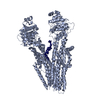
|
|---|---|
| 1 |
|
- Components
Components
| #1: Protein |  / CFTR / ATP-binding cassette sub-family C member 7 / Channel conductance-controlling ATPase / cAMP- ...CFTR / ATP-binding cassette sub-family C member 7 / Channel conductance-controlling ATPase / cAMP-dependent chloride channel / CFTR / ATP-binding cassette sub-family C member 7 / Channel conductance-controlling ATPase / cAMP- ...CFTR / ATP-binding cassette sub-family C member 7 / Channel conductance-controlling ATPase / cAMP-dependent chloride channelMass: 169353.578 Da / Num. of mol.: 1 Source method: isolated from a genetically manipulated source Source: (gene. exp.)   Homo sapiens (human) / Gene: CFTR, ABCC7 / Cell line (production host): HEK293S GnTI- / Production host: Homo sapiens (human) / Gene: CFTR, ABCC7 / Cell line (production host): HEK293S GnTI- / Production host:   Homo sapiens (human) / References: UniProt: P13569, EC: 3.6.3.49 Homo sapiens (human) / References: UniProt: P13569, EC: 3.6.3.49 |
|---|---|
| #2: Protein/peptide |  / CFTR / ATP-binding cassette sub-family C member 7 / Channel conductance-controlling ATPase / cAMP- ...CFTR / ATP-binding cassette sub-family C member 7 / Channel conductance-controlling ATPase / cAMP-dependent chloride channel / CFTR / ATP-binding cassette sub-family C member 7 / Channel conductance-controlling ATPase / cAMP- ...CFTR / ATP-binding cassette sub-family C member 7 / Channel conductance-controlling ATPase / cAMP-dependent chloride channelMass: 1635.006 Da / Num. of mol.: 1 / Fragment: R domain Source method: isolated from a genetically manipulated source Source: (gene. exp.)   Homo sapiens (human) / Gene: CFTR, ABCC7 / Cell line (production host): HEK293S GnTI- / Production host: Homo sapiens (human) / Gene: CFTR, ABCC7 / Cell line (production host): HEK293S GnTI- / Production host:   Homo sapiens (human) Homo sapiens (human) |
-Experimental details
-Experiment
| Experiment | Method:  ELECTRON MICROSCOPY ELECTRON MICROSCOPY |
|---|---|
| EM experiment | Aggregation state: PARTICLE / 3D reconstruction method:  single particle reconstruction single particle reconstruction |
- Sample preparation
Sample preparation
| Component | Name: human cystic fibrosis transmembrane conductance regulator (CFTR) Type: COMPLEX / Entity ID: all / Source: RECOMBINANT |
|---|---|
| Molecular weight | Value: 168 kDa/nm / Experimental value: NO |
| Source (natural) | Organism:   Homo sapiens (human) Homo sapiens (human) |
| Source (recombinant) | Organism:   Homo sapiens (human) / Cell: HEK293S GnTI- / Plasmid Homo sapiens (human) / Cell: HEK293S GnTI- / Plasmid : BacMam : BacMam |
| Buffer solution | pH: 7.5 |
| Specimen | Conc.: 5 mg/ml / Embedding applied: NO / Shadowing applied: NO / Staining applied : NO / Vitrification applied : NO / Vitrification applied : YES : YES |
Vitrification | Instrument: FEI VITROBOT MARK I / Cryogen name: ETHANE / Humidity: 100 % / Chamber temperature: 298 K |
- Electron microscopy imaging
Electron microscopy imaging
| Experimental equipment |  Model: Titan Krios / Image courtesy: FEI Company |
|---|---|
| Microscopy | Model: FEI TITAN KRIOS |
| Electron gun | Electron source : :  FIELD EMISSION GUN / Accelerating voltage: 300 kV / Illumination mode: FLOOD BEAM FIELD EMISSION GUN / Accelerating voltage: 300 kV / Illumination mode: FLOOD BEAM |
| Electron lens | Mode: BRIGHT FIELD Bright-field microscopy Bright-field microscopy |
| Image recording | Electron dose: 1.68 e/Å2 / Film or detector model: GATAN K2 SUMMIT (4k x 4k) |
- Processing
Processing
CTF correction | Type: NONE |
|---|---|
3D reconstruction | Resolution: 3.87 Å / Resolution method: FSC 0.143 CUT-OFF / Num. of particles: 415915 / Symmetry type: POINT |
 Movie
Movie Controller
Controller




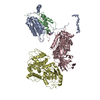
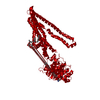
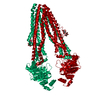
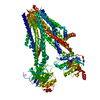
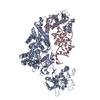
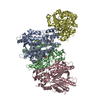
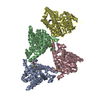
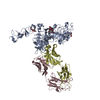
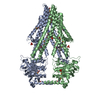
 PDBj
PDBj


